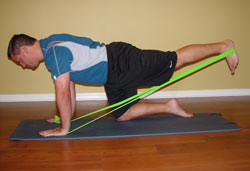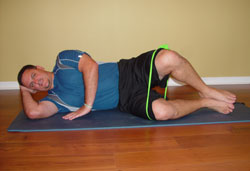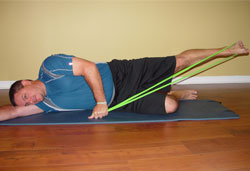Sports Specific

Pilates for Power in Your Golf Game
Golfers are a unique breed of athlete. Many go straight from their car to the driving range or the first tee box without any thought about the condition of their bodies. Are they warmed up, are they tight, did they stretch out and get prepared for the work that lies ahead? In most cases the answer is no. This is because they don’t view golf as an athletic pursuit or understand the affect their bodies can have on their games. Well, golf is definitely an athletic endeavor and building muscle and strength in the lower body can help prepare golfers for the rigors of the game. Adding a few extra yards to their drives wouldn’t hurt either.
Power in the golf swing is created in a couple different ways. Number one is the golfer’s swing efficiency. Simply put, does the swing maneuver and sequence lend itself to maximum power? For example, golfers who have swing faults such as Early Extension (hips move toward ball during the downswing causing a loss of posture), Swaying (hips move away from the target in the backswing) or Sliding (hips move toward the target on the downswing and during impact) are losing power because much of their energy transfer gets eaten up by unwanted movements. These movements are generally caused by weakness in the glutes and legs. Building strength in these areas can help golfers become more stable in their lower bodies allowing for a better transfer of energy.
The following three exercises can help build lower body strength and stability. All are based in Pilates and utilize Thera-band type resistance bands.
Quadruped Hip Extension Pilates Exercise

This Pilates exercise targets the glute max, shoulder and hip stabilizers, and hamstrings.
- Begin by wrapping the center of a band (approximately 6 feet in length) over the bottom of one foot then bring the ends of the band up into the hands.
- Get on all fours (quadruped position) with knees below hips and wrists below shoulders. Before beginning the exercise, make sure that the low back is in a neutral position (not arched!), that the shoulder blades are pulling down to engage the shoulder stabilizers (no dipping between the shoulder blades) and that the cervical spine is neutral (eyes toward the floor directly below).
- Inhale to prepare for the motion.
- Exhale and extend the leg with the band pressing the heel towards the wall directly behind you. Make sure that the heel doesn’t lift above the buttocks causing the low back to arch or dip.
- Inhale and return to the start position. Repeat for 10-15 repetitions. You should feel work in the glute of the extending leg as well as the core helping to stabilize the body.
Side-lying Clamshells Pilates Exercise

This exercise targets the glute medius, TFL and core.
- Get into a side-lying position bending the knees and hips both to about 90°. Wrap the Thera-band around both thighs, close to the knees making a fairly tight wrap. Make sure that the shoulders, hips and feet are stacked.
- Inhale to prepare for the motion.
- Exhale and lift the top knee toward the ceiling, making sure that the insides of both feet stay together.
- Inhale and return to the start position. Repeat for 10-15 repetitions or until you get a burn in the outside of the hip. It may not take very long. If it feels too easy, increase the tension in the band.
Side-lying Leg Lifts Pilates Exercise

This exercise targets the glute medius, TFL, core, and hip stabilizers.
- Begin by wrapping the center of a band (approximately 6 feet in length) over the top of one foot then bring both ends around and up into the same side hand.
- Lie on your side and extend the legs fully. The band should be on the side that is up. The body should be lined up very straight – ear, shoulder, hip, knee and ankle in a straight line. Lift the waistline off of the mat by engaging the abdominals. The bottom knee can be bent to help stabilize but much more core work is created by leaving both legs fully extended.
- Inhale and lift the top leg toward the ceiling, point the foot making sure that the hip and lateral malleolous stay aligned.
- Exhale, flex the foot and lower the leg, making sure to engage the adductors (inner thighs). Don’t allow the foot to rest down. Repeat for 10-15 repetitions.
Having strength in the lower body can definitely help a golfer retain power for his/her swing. It’s a vital component of the whole picture. Being fit for golf is one of the best things a golfer can do for their game and it’s a lot cheaper than a new set of clubs.




